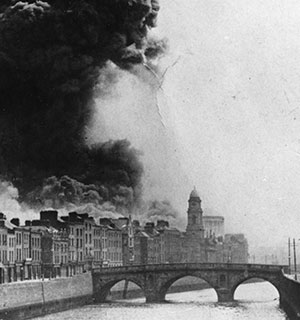BITE-SIZED HISTORY
Published in Issue 2 (March/April 2020), News, Volume 28BY TONY CANAVAN
Oireachtas 1919–2019 goes on-line
The Oireachtas Library and Research Service recently launched an on-line ‘Bibliography of Parliament 1919–2019’. The bibliography aims to be an authoritative but not exhaustive list of works relevant to the first 100 years of parliamentary self-government in Ireland. It was commissioned as part of the Houses of the Oireachtas Centenary Programme to commemorate the centenary of the First Dáil. It was compiled in partnership with the Department of Politics and Public Administration at the University of Limerick. Subjects covered include the administration and role of the Oireachtas, parliamentary business and parliamentary reform, as well as elections and members of the Oireachtas. The bibliography can be accessed on the Houses of the Oireachtas website, www.oireachtas.ie/en/visit-and-learn/bibliography/, via Zotero.org. By registering for a free account and joining the group, visitors can download or export items to guide further reading.
Dublin City Council to repossess historic Iveagh Market
Dublin City Council plans to repossess the Iveagh Market from Temple Bar hotelier Martin Keane, even though this means it will have to pay out €13m just to halt the dereliction of this Edwardian building. Two days before Christmas, Mr Keane lodged a new application to redevelop the Francis Street building, which has been in his possession for over twenty years. He wants to convert the derelict building into a European-style food hall, with restaurants, a distillery, a brewery and crafts workshops. The council has declared the application invalid, however, because of issues relating to the ownership of the property. The market was built early in the last century by the Guinness family, to house street traders who had been displaced by the construction of the nearby Iveagh Trust housing development on Patrick Street, and was handed over in trust to Dublin Corporation. By the 1980s the building had become very run-down and it eventually closed in the 1990s. In 1996 the council announced that it was seeking a private developer to regenerate the market. The following year Mr Keane secured the tender, with an agreement that the title of the market would be transferred to him once the redevelopment was completed, but the development became mired in an ownership row between Dublin City Council and the Guinness-family-controlled Iveagh Trust. The dispute was not resolved until 2004. Mr Keane originally applied for planning permission, which was granted by An Bord Pleanála in 2007, but before he could act on it the recession hit. We await the City Council’s plans for the site once it takes repossession.
Beyond 2022

Above: The Four Courts, 30 June 1922, moments after the explosion and fire that destroyed the Public Record Office. By the time of the centenary, on 30 June 2022, the Beyond 2022 project hopes to have recreated—virtually—as much of the PRO’s archives as possible in a digital format accessible to all. (Irish Architectural Archive)
The Beyond 2022: Ireland’s Virtual Record Treasury research project, aiming to retrieve documents from the Public Record Office (PRO) of Ireland that were destroyed in the Civil War fire, has entered its second phase following receipt of a €2.5 million government grant. Through a combination of enhanced scanning facilities, artificial intelligence, virtual reality and copies of the material found in other archives in Ireland, the UK, the US and France, it is hoped to retrieve or replicate many of the original records, dating back centuries. By 30 June 2022, the centenary of the fire, the project hopes to have recreated—virtually—as much of the PRO’s archives as possible in a digital format accessible to all. More than 200 volumes of transcripts, scattered between archives in the US, the UK and throughout Ireland, that were suitable for enhanced digitisation were identified. The handwritten records contain more than 25 million words from documents destroyed in 1922 and will help to create a ‘fully immersive, three-dimensional, virtual reality model of the digitally reconstructed Public Record Office of Ireland’, according to a government statement.
Holy cow—it’s heritage
It was recently announced that the Droimeann cow has been officially approved as a native rare Irish breed. Known for its distinctive white streak and white diamond of hair between the hind legs, the Droimeann cow has been recorded in many cultural and historical records in Ireland for over 1,000 years, such as the poem ‘Bo Bithbliacht Meic Lonan’ (AD 920) and songs like ‘An Droim Fhionn Donn Dilis’ and ‘Ailliu na Gamhna’. Following work by Weatherbys on DNA profiling using genotyping technology, the breed has been shown to be unique—that is, there is a genetic distance from other breeds of cattle in Ireland. As a result, the Department of Agriculture has officially recognised the Droimeann as a distinct breed. It joins the Dexter, the Kerry and the Irish Maol as one of four cow breeds to be handed ‘Native Rare Irish Breed’ status. There are currently 243 breeding females and 23 breeding males of the Droimeann around today. With such low numbers, the breed can be considered ‘at risk’ and its survival is of concern, but the Dromeann Cattle Society, with support from the department, is dedicated to ensuring that the numbers increase and that the breed will survive. The last breed to have been approved by the department as being native and rare was the Kerry Bog Pony fifteen years ago.
















